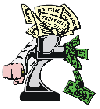INFORMATION ARTICLE

 |
26% Yield with NO competition (by John D. Behle) |
||||||||||||||||||||||||||||||||||||||||||||||||||||||||||||||||||||||||||||||||||||||||||||||||||||||||||||||||||||||||||||||||||||||||||||||||||||||
ONE OF MY
students sent me this example. It's a good example of a note
that many might not be able to calculate, would turn away
from, and many funding sources would not buy. Yet, when I can
invest some of my money at a 26% yield, I'm happy. The best
deals and profits in this industry come through your
creativity.
Dear John,This note has to be calculated all three ways. You always pay for a note based on the "Worst Case Scenario." Usually that is the longest term, but with the interest rate twists of this note, you need to calculate all three. Step One - Identify The Cash Flows Scenario One - no interest, no payments, paid within 22 months (subtracting the two months that have already passed). There is one cash flow which is $32,250 paid in 22 months (take the longest possible period). This is a lump sum cash flow and simple to calculate. Go to step three. Scenario
Two -
5% interest, no payments for 22 months and then
interest only payments and a balloon in 34 months. The
cash flows are:
CF1 = payments of X amount beginning in 22
months and payable for 12 months.
CF2 = a lump sum payment of Y amount payable
in 34 months. Scenario Three - 10% interest, no payments for 22 months, interest only payments for 12 months (based on 5% - since the 10% hasn't kicked in yet), and a balloon in 34 months. Step Two - Solve For Any Unknown Factors Scenario One - There are no unknown factors, go to step three Scenario
Two -
Since interest accrues for two years on the $32,250,
then we have a higher amount and the interest only payment
would be based on that amount. The lump sum (balloon) payment
in 34 months would be this higher figure. The first
calculation shows the amount the loan will grow to in a total
of 24 months.
So our cash flows then are:
CF1 = $148.48 per month for 12 months
(beginning in 22 months)
CF2 = $35,634.36 in 34 months. Scenario
Three -
The interest accrues for two years at 10%. The interest
only payment is based on 5% and therefore 5%
continues to accrue for another 12 months.
First we need to know how much the note grows to in the two
years.
Since we know what the payment would be based on the last
calculations, we can plug that in. The loan will be in a
reverse amortization mode ("Walking Backwards")
and we need to know how much the balloon payment will be.
Step Three - Discount and Add the Cash Flows Scenario
One
- CF1 = $32,250 in 22 months.
First we'll look at what we might pay based on his
suggested yield of 18%, then we'll look at what the
yield would be if we paid the $20,000 that he suggested
as his bottom line.
Scenario
Two
CF1 = $148.48 per month for 12 months
(beginning in 22).
Since this is a "Future Series" cash flow,
we need to factor in the 22 months we wait for the cash
flow to begin. We do this by discounting a second time. We
take the value of the cash flow ($1,619.55) and then
discount that value as a lump sum payment due in 22
months.
Now for cash flow two:
Total value of both cash flows at 18% = $1,167.19
+ $21,479.47 = $22,646.66
Yield if we paid $20,000 for the note = 21.88% Scenario
Three
CF1 = $148.48 per month for 12 months
beginning in 22 months. CF1 value is $1,167.19 as determined in the
last example.
Total value of both cash flows - 18% yield = $25,083.32
+ $1,167.19 = $26,250.51
The yield (IRR) if we paid $20,000 for the note
would be 27.08%.
Conclusion
With the interest rate twist on this note, it is more
valuable as time goes by. So we would buy based on the
shortest term 0% interest scenario - and hope it goes
longer.
One crucial factor with creatively structured notes is
whether they are enforceable. Sometimes the two different
parties have different interpretations as to what happens
when. The important thing is "what does the note
say?" Most of the time they are not worded and put
together by attorneys (which doesn't necessarily mean much
anyway) and can be vague and parts could be un-enforceable
because of that.
Assuming the note and property check out, it could be a
good deal - assuming an investor can forego the need for cash
flow for the first 22 months and monitor the note
properly. There can be greater risks and a greater need for
monitoring if the note does not have monthly payments. Go
The Extra Mile
Many investors will not buy these notes. Some would turn
away just because they do not want to deal with the creative
payment structure. The real sad news is many investors would
turn away because they couldn't figure the yields and IRR.
Many note investors have way too little financial and real
estate background to even be in the business. If you educate
yourself and go the extra mile in analyzing
"creative" notes, you won't have any competition!
About the Author . . . John holds an National Council of Exchangors "Gold
Card" and an EMS designation. He is also listed in Who's
Who In Creative Real Estate. John Behle is the author of
several hundred articles published in national magazines and
newsletters and of several ground-breaking real estate paper
books, including: * The Paper Game Trilogy |
|||||||||||||||||||||||||||||||||||||||||||||||||||||||||||||||||||||||||||||||||||||||||||||||||||||||||||||||||||||||||||||||||||||||||||||||||||||||
![]() To
Fax this article to someone else for free click on the
box.
To
Fax this article to someone else for free click on the
box.
Home
Free Articles